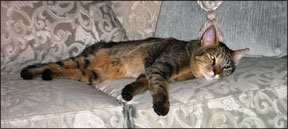Dealing with Chronic Kidney Disease
What once was termed “renal failure” is now called feline chronic kidney disease (CKD), in part because the word “failure” sounded too terminal: Many cats live on for years (with treatment) with chronic kidney disease.

288
One such survivor was the first ShortTakes office manager, the late, great Gertie. That stalwart kitty was diagnosed with renal failure in “middle age,” around 11 years old. She hung on to see her 20th birthday – a little shaky toward the end – but mostly thriving with good “quality of life” thanks to expert veterinary care, therapeutic renal diets, blood pressure medicine for her hypertension, and plenty of fresh water for the thirst that goes along with kidney disease.
The current ShortTakes cat, Frannie, is young (around three years old) with apparently healthy kidneys – but still, you never know. Along comes an article in the Journal of Feline Medicine and Surgery (Vol. 11, Issue 3) titled “Therapies for Feline Chronic Kidney Disease.” Of particular interest are “10 Tips to Encourage Acceptance of Therapeutic Renal Foods.” Here are some that worked with Gertie, and some interesting new ideas:
- Transition from old to new diets gradually, providing some previous food with the prescription renal food at first.
- You should feed in a flat dish, rather than a bowl. “This avoids the cats whiskers rubbing on the food dish, which could affect acceptance of a new food.” And be sure to thoroughly clean your cat’s bowls each day, too.
- Serve food at room temperature, and warm it after refrigerator storage.
- Experiment with different textures and types, and try different brands to find ones your cat loves.
“Inactivity” Blamed for Diabetes
Dry cat food may be getting a bad rap – for the increase in feline diabetes in this country, according to a report in Veterinary Journal (Vol. 179, Issue 3). The article, titled “Indoor confinement and physical inactivity rather than the proportion of dry food are risk factors in the development of feline type 2 diabetes mellitus,” discounts a theory that seemed to make sense: With domestication and urbanization, cats went from being hunting animals that ate protein-rich prey to more sedentary animals the eat carbohydrate-rich diets – particularly dry cat food.
But telephone surveys of 96 owners whose cats have diabetes – compared with a “control” group of 192 owners of health cats – showed that the energy percentage (from carbohydrates, fats, and proteins) in diets of diabetic cats and healthy ones is not related to the development of diabetes mellitus. A cushy indoor life without much exercise is.
Heres the CW ShortTakes take: Dont release an indoor cat to a life of hunting in the wild. But if the phone rings, remember to say: “Fluffy cant come to the phone right now because shes too busy exercising.” In other words, you should understand the risks of a sedentary indoor life (some 53 percent of American cats are considered obese or overweight) and do your best to reduce those pounds.



